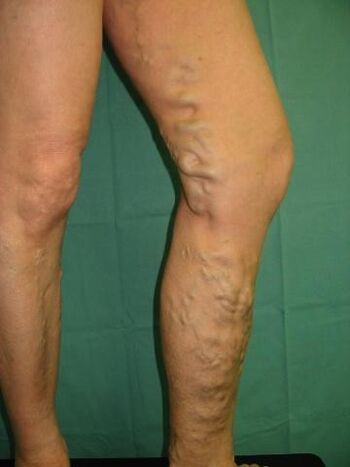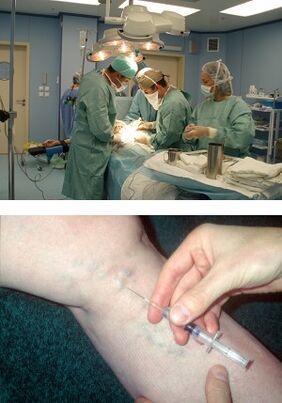Varicose veins or in common people, varicose veins are the lengthening and expansion of irreversible and persistent veins, mainly of the lower extremities, as well as the formation of certain "ganglia" as a consequence of a pathology of the venous walls or due to a genetic defect. (insufficiency of your valves).
Today, varicose veins are a very common disease. It affects one in ten men and one in three women. The more a person leads a sedentary and inactive lifestyle, the more susceptible they are to this disease.
USA, France, UK: They are the leading countries in the prevalence of varicose veins (more than 30% of the population on average).
The causes of varicose veins.
This utility appears with an increase in venous pressure. It is generally accepted that varicose veins are exclusively of the lower end, however, there are varicose veins of the esophagus, stomach, testicular veins or varicose veins of the small pelvis.
By the way, the latter is one of the reasons for a fairly common disease like hemorrhoids.
The main reasons for the development of varicose veins include:
- Gender - often in female representatives, varicose veins are provoked by the intake of various hormonal drugs or pregnancy.
- Inheritance
- Increased venous pressure, even due to weight problems, a sedentary lifestyle.
The above reasons contribute to both the expansion of the veins and the disruption of the usual normal functioning of the venous valves.
Stages of the disease
The following stages of varicose veins are distinguished:
- Initial- characterized by leg pain, swelling and heaviness. Prevention of the disease at this stage, after all, is more appropriate.
- First stage- Knotty veins, spider veins, which can be seen through the skin, also add to the above symptoms. A burning sensation in the foot and calf area is often possible.
- Second stage- the number of varicose veins and asterisks increases sharply, becoming more visible. The pain becomes unbearable, the legs are draining a lot.
- Third stage- here the skin of the legs is directly affected. It becomes cracked, lifeless and dry. In addition, it is possible to change the pigmentation and structure of the skin of the legs. The venous ganglia begin to acquire a convex shape.
What about varicose veins?

One of the first symptoms of varicose veins is frequent leg swelling, distention and heaviness of the calves when sitting for a long time.
Likewise, no less characteristic of varicose veins is the reduction or disappearance of these symptoms after a night of rest or a walk.
If you do not start the treatment in time, the following symptoms appear: explosive pains in the calves, cramps in the calf muscles, feeling of heat in the legs.
Also on the legs, red-blue vascular "stars" can be seen, the saphenous veins expand, and dark blue intradermal veins can be seen.
With advanced varicose veins, thrombophlebitis (inflammation of the dilated veins with the formation of blood clots in them), eczema in the affected areas, or trophic ulcers can develop.
To eliminate the risks of the manifestation of varicose veins, it is necessary to get rid of the main causes of their appearance and external factors: smoking, alcohol, unhealthy diet.
Varicose veins in the lower extremities develop from a lack of fiber-rich foods in the diet. It is an intestinal cleanser that removes waste, pus, toxins, and radionuclides from the body.
Forms of varicose veins
There are the following types (forms) of lower end varicose veins:
- Localized venous lesion with defective secretion by communicative or pathological veins.
- Localized lesion of intradermal or subcutaneous vessels without reflux.
- Generalized venous involvement with defective deep venous blood flow.
- Generalized injury to the veins with poor blood flow through the communicating veins.
Also, isolated separately, a shape like the reticular shape of varicose veins. It is a kind of common varicose veins, with it there is an expansion of thin intracutaneous veins.
Diagnostics

Observing the initial symptoms, you should immediately contact a specialist who deals with venous diseases - a phlebologist.
Success in treating leg varicose veins largely depends on when treatment began. Naturally, the sooner you see a doctor, the lower the risk of complications.
After the first examination, the doctor will prescribe an instrumental examination, usually a Doppler ultrasound.
It happens that radiopaque and radionuclide methods are used, if the need arises.
With these methods, special substances are injected into the bloodstream and then their distribution through the blood vessels is studied.
How to treat varicose veins
Varicose veins can be treated with 3 methods:
- Sclerotherapy.
- Performing a surgical operation on varicose veins.
- Medication (conservative treatment).
In addition to the above methods, the complex uses medical knitwear and physical therapy exercises.
We will consider each of the 3 methods in more detail below.
Sclerotherapy

Scleteropia is a painless, non-surgical, and most importantly, high-quality and effective method of treating varicose veins. This is a fairly young way to treat varicose veins compared to others.
One of the main advantages of sclerotherapy is that the treatment does not require hospitalization, that is, it is performed on an outpatient basis, and that it does not affect in any way the patient's usual rhythm of life.
The essence of the method lies in the fact that a special sclerosing drug is carefully injected into the "diseased" vein, causing a kind of "sticking" of the veins.
After the procedure is finished, a bandage is applied, which must be worn for a week. During this time, the vein grows too large, after which it disappears and blood flow is restored.
Unfortunately, not all types of varicose veins can be treated with this method. If the patient needs surgery, not only will sclerotherapy not help in this case, it can also cause a number of complications and possibly even deterioration.
For example, there is a classification of varicose veins according to the guarantor, where varicose veins are divided into degrees, and this method can only treat 1st degree varicose veins.
Regarding the consequences of sclerotherapy, it involves the preservation of small bruises for a short period and a slight pigmentation of the "diseased" veins.
Performed by a professional doctor, this method guarantees a long-lasting result: dilated veins "close" and blood flow never returns through them.
Operation
Surgical treatment of varicose veins or laser surgery for varicose veins. Currently, this method is one of the main ones. One, there are a number of contraindications:
- During pregnancy or in women who have just given birth, it is recommended to wait at least 5 weeks, since in many cases varicose veins that have arisen during pregnancy disappear on their own without any intervention.
- If you are exclusively concerned about the aesthetic side of the problem and there are no other symptoms (inflammation of the veins, pain).
- A surgical method to treat varicose veins is indicated only if others do not make sense or will not give results.
Treatment of varicose veins with a surgical method is carried out, as a rule, on an outpatient basis, without hospitalization of the patient.
There are 3 methods of surgical treatment of varicose veins: ligation, extraction, and microflebectomy.
- Ligature- It is a kind of varicose vein ligation. As a rule, this method is used in combination with others, for example, it serves as an adjunct to extraction or phlebectomy.
- Peel- a surgical method for the treatment of varicose veins, in which the "diseased" vein is removed with a small fine probe.
- Microphlebectomy- The essence lies in the elimination of varicose veins by means of a puncture, which is carried out on the skin.
Drug treatment method.
Pharmacotherapy is an equally important component in the treatment of varicose veins. Competently selected drugs will help not only to eliminate the fairly basic manifestations of varicose veins, but also to reduce the risk of complications.
Most of these medications help relieve swelling and pain syndromes, improve blood flow, etc.
These medications help in the following:
- Improves lymphatic drainage function.
- Increases general venous tone.
- Improves microcirculation of bleeding disorders.
It should be noted that the use of these drugs, like any other, should be carried out exclusively after a thorough examination and as prescribed by a doctor.
Treatment with home remedies for varicose veins.
In addition to traditional medicine, there are also recipes from the "popular" first aid kit:
- Take a couple of garlic cloves and chop them finely. Please note that only white peel garlic is used! Then stir it with two tablespoons of butter. We apply the resulting porridge to the "sore" veins of the night, on top of parchment paper, secure with a tight bandage and at the end we wrap it with a warm scarf. In the morning, after showering, we put on something warm.
- Hops infusion is an equally effective folk remedy for varicose veins. Take hop cones (be sure to dry) and pour 1 glass of boiling water. Let steep for an hour and then feel free to drink the infusion half an hour before meals in a glass.
And remember that varicose veins are not a sentence, it is still possible and necessary to be treated, and the sooner you go to a specialist, the easier and more effective the treatment itself will be.
Be healthy!






































